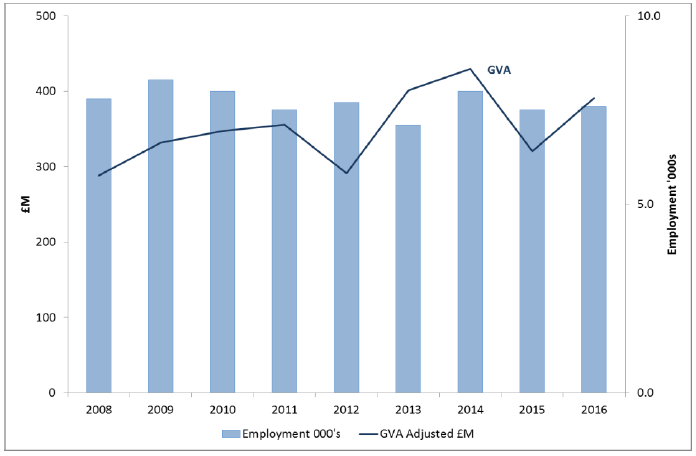Scotland's marine economic statistics 2016
The publication presents economic statistics for industrial categories defined as part of the marine sector.
6. Seafood Processing
The seafood processing industry is defined in SABS as “Processing and preserving of fish, crustaceans and molluscs”. In this publication SABS information on seafood processing is used as the source data. Seafish produces a 2016 Seafood Processing Industry Report which presents economic values for processing of sea fish. However the methodological differences mean that the SABS data allows for better comparisons with other industry results (see the Methodology section).
SABS employment figures for ‘Processing and preserving of fish, crustaceans and molluscs’ are almost twice that of the Seafish employment values. The main difference is the inclusion of aquaculture processing in the SABS survey and not in the Seafish survey. This highlights the importance of salmon in the processing economy. The Seafish employment survey is carried out every two years. SABS employment figures are reported in Table 10.
While fish processing is predominantly a terrestrial activity, the bulk of processing in Scotland is highly dependent on fish landed in Scottish waters. Therefore fish processing has been included in the marine economy.
6.1 Key economic points
In 2016 seafood processing generated £391 million GVA: accounting for 0.3 % of the overall Scottish economy, and 10 % of the marine economy.
In terms of employment, fish processing provided employment for 7,600 workers, again contributing 0.3 % to total Scottish employment, and 10 % of the marine economy employment.
6.2 Seafood Processing – trends
Table 10 : Seafood processing - GVA, turnover, employment and GVA per head, 2008 to 2016 (2016 prices)
| Year | GVA £M | Turnover £M | Employment Headcount 000's | GVA Per Head £ |
|---|---|---|---|---|
| 2008 | 288 | 1,235 | 7.80 | 36,944 |
| 2009 | 332 | 1,618 | 8.30 | 39,952 |
| 2010 | 347 | 1,593 | 8.00 | 43,437 |
| 2011 | 355 | 1,371 | 7.50 | 47,389 |
| 2012 | 291 | 1,400 | 7.70 | 37,767 |
| 2013 | 401 | 1,635 | 7.10 | 56,443 |
| 2014 | 430 | 1,737 | 8.00 | 53,705 |
| 2015 | 320 | 1,597 | 7.50 | 42,703 |
| 2016 | 391 | 1,602 | 7.60 | 51,395 |
Between 2008 and 2016 seafood processing GVA (adjusted to 2016 prices) increased by one third while employment fell by 3%.
Figure 8: Seafood processing – GVA and employment, Scotland, 2008 to 2016

With some variation from year to year, employment in seafood processing in Scotland has changed little over the period from 2008 to 2015. GVA reached a record value in 2014, but fell to a second lowest value in 2015 before recovering in 2016.
6.3 Seafood Processing by geography
The Food Standards Agency publish a full list of establishments approved to handle, prepare or produce products of animal origin, including fish processing plants. The information is provided by local authority and this list was used to provide the number of fish processing businesses in Scotland. It does not consider volume of throughput, or type of fish.
As of September 2018, there were 284 registered fish processing plants in Scotland. The three local authorities with the highest number of plants were Aberdeenshire (52), Highland (43) and Aberdeen City (38).
Contact
There is a problem
Thanks for your feedback